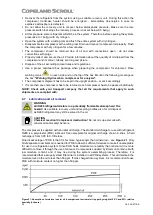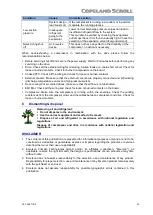
C6.2.38/0719/E
29
CAUTION
Low suction pressure operation! Compressor damage!
Do not operate
with a restricted suction. Do not operate with the low-pressure limiter bridged.
Do not operate compressor at pressures that are not allowed by the operating
envelope. Allowing the suction pressure to drop below the envelope limit for
more than a few seconds may overheat scrolls and cause early drive bearing
and moving parts damage.
Qualified refrigerant and oil can be found in
Chapter 2.5.1.
It is not necessary to replace the refrigerant with new unless contamination due to an error such as
topping up the system with an incorrect refrigerant is suspected. To verify correct refrigerant
composition, a sample can be taken for chemical analysis. A check can be made during shut down
by comparing the refrigerant temperature and pressure using precision measurements at a location
in the system where liquid and vapour phases are present and when the temperatures have
stabilised. In the event that the refrigerant needs replacing, the charge should be recovered using a
suitable recovery unit.
6.6 Replacing a compressor
CAUTION
Inadequate lubrication! Bearing destruction!
For systems with refrigerant
accumulator, exchange the accumulator after replacing a compressor with a
burned-out motor. The accumulator oil return orifice or screen may be plugged
with debris or may become plugged. This will result in starvation of oil to the
new compressor and a second failure.
Remove the refrigerant and oil completely from the replaced compressor.
6.6.1 Compressor replacement
In the case of an R290 compressor replacement the oil has to be drained out of the compressor and
the compressor should be flushed with dry nitrogen. DO NOT close the stubs with plugs.
In the case of a motor burnout, the majority of contaminated oil will be removed with the compressor.
The rest of the oil is cleaned through the use of suction and liquid line filter driers. A 100% activated
alumina suction line filter drier is recommended but must be removed after 72 hours.
6.6.2 Start-up of a new or replacement compressor
Rapid charging only on the suction side of a scroll-equipped system can occasionally result in a
temporary no-start condition for the compressor. The reason for this is that, if the flanks of the scrolls
happen to be in a sealed position, rapid pressurisation of the low side without opposing high-side
pressure can cause the scrolls to seal axially. As a result, until the pressures eventually equalise,
the scrolls can be held tightly together preventing rotation. The best way to avoid this situation is to
charge on both the high and low sides simultaneously at a rate which does not result in axial loading
of the scrolls.
A minimum suction pressure specified in the published operating envelope must be maintained
during charging. Allowing the suction pressure to drop below that value may overheat the scrolls and
cause early drive bearing and moving parts damage. Never install a system in the field and leave it
unattended when it has no charge, a holding charge, or with the service valves closed without
securely electrically locking out the system. This will prevent unauthorised personnel from
accidentally operating the system and potentially ruining the compressor by operating with no
refrigerant.
Do not start the compressor while the system is in a deep vacuum.
Internal arcing
may occur when a scroll compressor is started in a vacuum causing burnout of the internal lead
connections.
6.6.3 Compressor return procedure
If a compressor has to be returned to the manufacturer for analysis the procedure below shall be
followed:
▪
During the entire working procedure continuously check if the ambient atmosphere is explosive.
If explosive atmosphere is detected, ensure proper ventilation of the working space and
immediately cut-off the power supply.
▪
Resume working after the atmosphere is no longer dangerous.






















